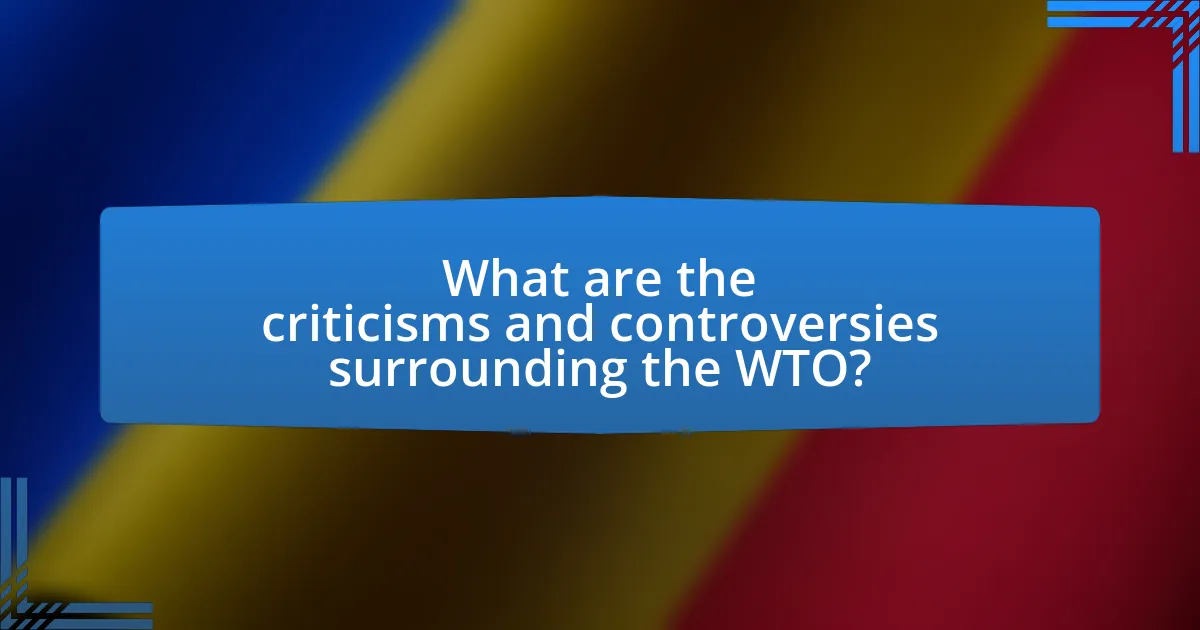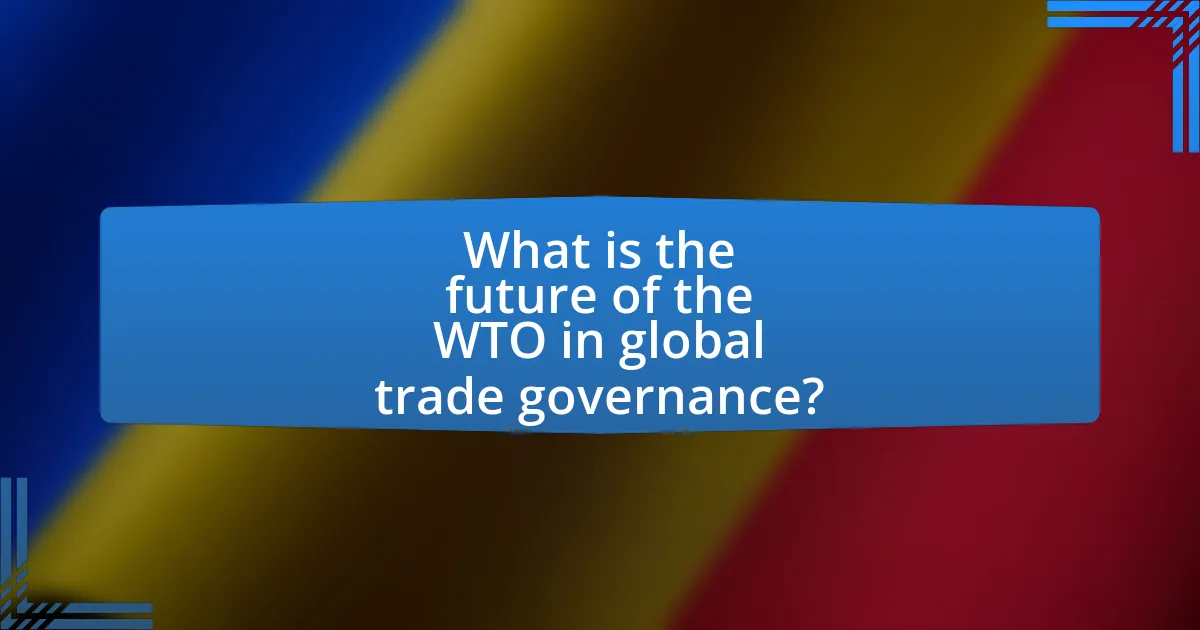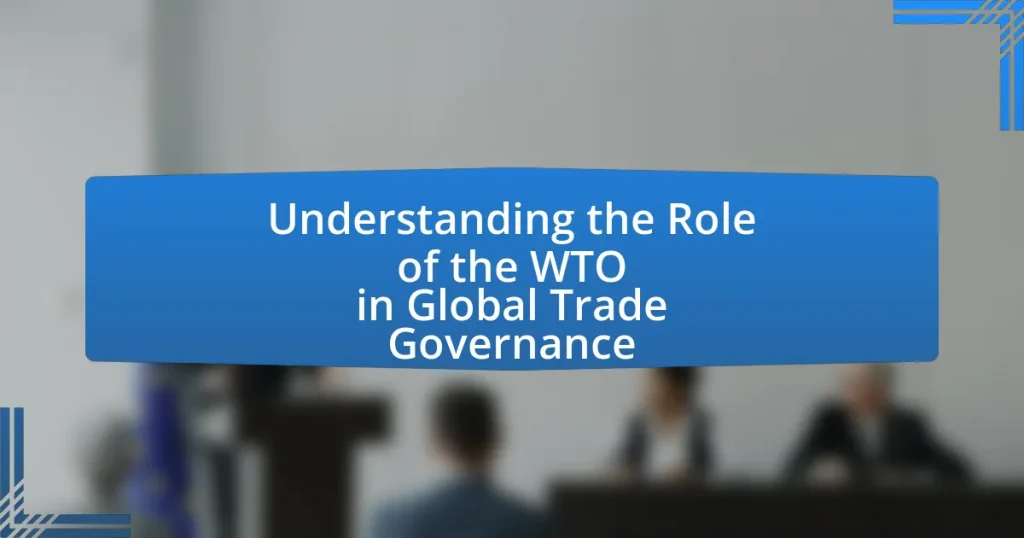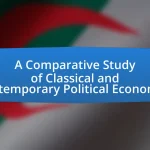The World Trade Organization (WTO) is an intergovernmental organization established on January 1, 1995, that regulates international trade among over 160 member countries. The article provides a comprehensive overview of the WTO’s significance in global trade governance, detailing its foundational principles, key agreements, and main functions, including trade negotiations, dispute resolution, and monitoring national trade policies. It also addresses the challenges the WTO faces, such as rising protectionism and criticisms regarding its impact on developing countries, labor rights, and environmental standards. Furthermore, the article explores the WTO’s efforts to adapt to modern trade dynamics and the implications of geopolitical shifts on its relevance in the global trading system.

What is the WTO and its significance in global trade governance?
The World Trade Organization (WTO) is an intergovernmental organization that regulates international trade. Established on January 1, 1995, the WTO aims to ensure that trade flows as smoothly, predictably, and freely as possible among its member countries, which number over 160. The significance of the WTO in global trade governance lies in its role as a forum for trade negotiations, a platform for settling trade disputes, and a body that monitors national trade policies. The WTO also provides technical assistance and training for developing countries, promoting equitable trade practices. Its agreements cover goods, services, and intellectual property, establishing a comprehensive framework that facilitates international commerce and economic cooperation.
How was the WTO established and what are its foundational principles?
The World Trade Organization (WTO) was established on January 1, 1995, following the conclusion of the Uruguay Round of trade negotiations, which began in 1986. The WTO emerged from the General Agreement on Tariffs and Trade (GATT), which was created in 1947 to promote international trade by reducing tariffs and other trade barriers. The foundational principles of the WTO include the promotion of free trade, non-discrimination through the Most-Favored-Nation (MFN) and National Treatment principles, transparency in trade regulations, and the encouragement of fair competition. These principles aim to create a stable and predictable trading environment, facilitating economic growth and development among member countries.
What key agreements form the basis of the WTO’s operations?
The key agreements that form the basis of the WTO’s operations are the General Agreement on Tariffs and Trade (GATT), the General Agreement on Trade in Services (GATS), and the Trade-Related Aspects of Intellectual Property Rights (TRIPS). GATT, established in 1947, focuses on trade in goods and aims to reduce tariffs and other trade barriers. GATS, introduced in 1995, governs international trade in services, promoting fair and equitable trade practices. TRIPS, also established in 1995, sets minimum standards for intellectual property protection, balancing the interests of creators and users. These agreements collectively underpin the WTO’s framework for facilitating global trade and resolving disputes among member countries.
How does the WTO’s structure support its mission in global trade?
The World Trade Organization’s (WTO) structure supports its mission in global trade by providing a framework for negotiating trade agreements, resolving disputes, and monitoring trade policies among member countries. This structure includes a Ministerial Conference, which is the highest decision-making body, and a General Council that oversees day-to-day operations and dispute resolution. The WTO’s rules-based system ensures that trade flows as smoothly, predictably, and freely as possible, which is essential for fostering international trade cooperation. For instance, the Dispute Settlement Understanding (DSU) allows member countries to resolve trade disputes in a structured manner, enhancing compliance with trade agreements and reducing trade tensions. This systematic approach to governance underpins the WTO’s effectiveness in promoting fair trade practices globally.
What are the main functions of the WTO in international trade?
The main functions of the World Trade Organization (WTO) in international trade include facilitating trade negotiations, administering trade agreements, monitoring national trade policies, providing a forum for trade dispute resolution, and offering technical assistance and training for developing countries. These functions are essential for promoting a stable and predictable trading environment. For instance, the WTO oversees the implementation of trade agreements such as the General Agreement on Tariffs and Trade (GATT), which has been pivotal in reducing tariffs and other trade barriers since its inception in 1947. Additionally, the WTO’s Dispute Settlement Body plays a crucial role in resolving trade disputes between member countries, ensuring that trade flows smoothly and fairly.
How does the WTO facilitate trade negotiations among member countries?
The World Trade Organization (WTO) facilitates trade negotiations among member countries by providing a structured forum for dialogue and agreement on trade rules. This organization enables member countries to engage in multilateral negotiations, where they can discuss and resolve trade-related issues collectively. The WTO’s established framework includes the General Agreement on Tariffs and Trade (GATT) and various trade agreements that set the rules for international trade, ensuring transparency and predictability. Additionally, the WTO conducts trade policy reviews, which allow members to assess each other’s trade policies and practices, fostering accountability and cooperation. This systematic approach has led to significant trade agreements, such as the Uruguay Round, which expanded global trade and reduced tariffs, demonstrating the effectiveness of the WTO in facilitating negotiations.
What role does the WTO play in resolving trade disputes?
The World Trade Organization (WTO) plays a crucial role in resolving trade disputes by providing a structured process for member countries to address and settle their trade disagreements. The WTO’s Dispute Settlement Body (DSB) facilitates this process, allowing countries to bring complaints against each other regarding violations of trade agreements. The DSB employs a panel of experts to review the case, issue findings, and recommend solutions, which member countries are obligated to follow under the WTO agreements. Historically, the WTO’s dispute resolution mechanism has been effective, with over 500 disputes brought to the organization since its inception in 1995, demonstrating its significance in maintaining global trade order and compliance.
What impact does the WTO have on global economic policies?
The World Trade Organization (WTO) significantly influences global economic policies by promoting trade liberalization and establishing a framework for international trade agreements. The WTO facilitates negotiations among member countries, leading to reduced tariffs and trade barriers, which enhances global market access. For instance, the Uruguay Round negotiations resulted in the General Agreement on Tariffs and Trade (GATT), which lowered tariffs by an average of 40% across member nations. Additionally, the WTO provides a dispute resolution mechanism that helps maintain stability in international trade relations, ensuring that countries adhere to agreed-upon rules. This framework fosters a predictable trading environment, which is essential for economic growth and investment.
How does the WTO influence national trade policies of member states?
The World Trade Organization (WTO) influences national trade policies of member states primarily through its framework of agreements and dispute resolution mechanisms. By establishing rules that govern international trade, the WTO encourages member states to align their trade policies with these agreements, which include commitments to reduce tariffs and eliminate trade barriers. For instance, the General Agreement on Tariffs and Trade (GATT) sets guidelines that member countries must follow, promoting transparency and fairness in trade practices. Additionally, the WTO’s dispute settlement system provides a structured process for resolving trade disputes, which compels countries to adhere to agreed-upon rules and norms. This system has been instrumental in maintaining trade relations and ensuring compliance, as evidenced by the numerous cases adjudicated since the WTO’s inception in 1995, reinforcing the importance of the organization’s influence on national policies.
What are the implications of WTO regulations on developing countries?
WTO regulations significantly impact developing countries by shaping their trade policies and economic growth. These regulations often require developing nations to adhere to trade liberalization, which can lead to increased market access and foreign investment. However, they may also impose challenges such as limited capacity to comply with complex rules and potential exposure to competition that local industries may not withstand. For instance, the Trade Policy Review Mechanism of the WTO assesses member countries’ trade policies, which can pressure developing nations to reform their practices. Additionally, studies indicate that while some developing countries benefit from preferential trade agreements, others struggle to leverage these opportunities effectively due to infrastructural and institutional constraints.
How does the WTO adapt to changes in global trade dynamics?
The World Trade Organization (WTO) adapts to changes in global trade dynamics through ongoing negotiations, updates to trade agreements, and the establishment of new trade rules. For instance, the WTO has facilitated discussions on e-commerce and digital trade, recognizing the growing importance of these sectors in the global economy. Additionally, the organization conducts regular reviews of member countries’ trade policies, which helps identify emerging trends and challenges. The WTO’s Trade Facilitation Agreement, implemented in 2021, exemplifies its responsiveness to the need for streamlined customs procedures, enhancing efficiency in international trade. These actions demonstrate the WTO’s commitment to evolving alongside the complexities of global trade.
What challenges does the WTO face in the current global trade environment?
The World Trade Organization (WTO) faces significant challenges in the current global trade environment, primarily due to rising protectionism, trade tensions among major economies, and the need for reform in its dispute resolution mechanism. Protectionist measures have increased, with countries implementing tariffs and trade barriers that undermine the principles of free trade established by the WTO. For instance, the U.S.-China trade war exemplifies how escalating tariffs can disrupt global supply chains and create uncertainty in international markets. Additionally, the WTO’s dispute resolution system has been criticized for its inefficiency, particularly after the Appellate Body became non-functional in late 2019, limiting the organization’s ability to resolve trade disputes effectively. These challenges hinder the WTO’s capacity to facilitate smooth global trade and adapt to evolving economic dynamics.

What are the criticisms and controversies surrounding the WTO?
The World Trade Organization (WTO) faces several criticisms and controversies primarily related to its impact on developing countries, environmental standards, and labor rights. Critics argue that the WTO’s policies favor wealthier nations, leading to unequal trade benefits and exacerbating poverty in developing countries. For instance, the WTO’s Agreement on Trade-Related Aspects of Intellectual Property Rights (TRIPS) has been criticized for prioritizing corporate profits over public health, limiting access to essential medicines in poorer nations. Additionally, the organization has been accused of undermining environmental protections by promoting trade over sustainable practices, as seen in disputes involving environmental regulations and trade agreements. Labor rights advocates also contend that the WTO does not adequately address workers’ rights, allowing countries to exploit cheap labor without enforcing fair labor standards. These criticisms highlight significant concerns regarding the WTO’s role in global trade governance and its implications for social equity and environmental sustainability.
Why do some countries oppose the WTO’s policies?
Some countries oppose the WTO’s policies due to concerns over sovereignty, economic inequality, and the prioritization of trade liberalization over social and environmental standards. For instance, developing nations often argue that WTO rules favor wealthier countries, limiting their ability to protect local industries and implement necessary regulations. Additionally, critics highlight that the WTO’s dispute resolution mechanisms can undermine national laws, leading to tensions regarding self-governance. These positions are supported by various studies, including a 2019 report from the United Nations Conference on Trade and Development, which emphasizes the disproportionate impact of WTO policies on developing economies.
What are the main arguments against the WTO’s influence on sovereignty?
The main arguments against the WTO’s influence on sovereignty include the erosion of national decision-making power, the prioritization of trade over local laws, and the imposition of external regulations that may conflict with domestic policies. Critics argue that the WTO’s dispute resolution mechanism can override national laws, leading to situations where countries must alter their regulations to comply with WTO rulings, thereby undermining their sovereignty. For instance, the case of the United States versus the European Union over hormone-treated beef illustrates how WTO decisions can compel nations to change their food safety standards, which are often rooted in local public health concerns. Additionally, opponents contend that the WTO favors multinational corporations, allowing them to challenge national regulations that protect local industries and labor rights, further diminishing the ability of governments to act in the best interest of their citizens.
How do critics view the WTO’s impact on labor and environmental standards?
Critics view the WTO’s impact on labor and environmental standards as largely negative, arguing that its policies prioritize trade liberalization over the protection of workers’ rights and environmental sustainability. They contend that the WTO’s framework often undermines national regulations designed to safeguard labor conditions and environmental health, leading to a “race to the bottom” where countries may lower standards to attract foreign investment. For instance, a report by the International Labor Organization highlights that trade agreements facilitated by the WTO can exacerbate inequalities and weaken labor protections, particularly in developing nations. Additionally, environmental advocates assert that the WTO’s emphasis on free trade can hinder efforts to implement stricter environmental regulations, as seen in disputes where countries have faced challenges for prioritizing environmental protections over trade interests.
How has the WTO responded to criticisms and calls for reform?
The World Trade Organization (WTO) has responded to criticisms and calls for reform by initiating discussions on improving its processes and addressing member concerns. In recent years, the WTO has acknowledged the need for modernization, particularly in areas such as e-commerce, trade and health, and environmental sustainability. For instance, the organization has launched initiatives like the Joint Statement Initiative on e-commerce, which aims to create global rules for digital trade. Additionally, the WTO has held various ministerial conferences to facilitate dialogue among member countries regarding necessary reforms, including enhancing transparency and addressing the concerns of developing nations. These actions demonstrate the WTO’s commitment to adapting to the evolving global trade landscape while responding to the diverse needs of its members.
What initiatives has the WTO undertaken to improve transparency and inclusivity?
The World Trade Organization (WTO) has undertaken several initiatives to improve transparency and inclusivity, including the Trade Policy Review Mechanism (TPRM) and the Enhanced Integrated Framework (EIF). The TPRM allows for regular reviews of member countries’ trade policies, promoting accountability and transparency in trade practices. The EIF aims to integrate least developed countries into the global trading system by providing them with technical assistance and capacity-building support, thereby enhancing their participation in international trade. These initiatives are designed to foster a more inclusive trading environment and ensure that all member countries can engage effectively in global trade governance.
How does the WTO plan to address the concerns of marginalized nations?
The World Trade Organization (WTO) plans to address the concerns of marginalized nations by enhancing their participation in global trade discussions and providing technical assistance. The WTO recognizes that marginalized nations often face barriers to trade, which can hinder their economic development. To combat this, the organization has implemented initiatives such as the Aid for Trade program, which aims to help developing countries build the necessary infrastructure and capacity to engage effectively in international trade. Additionally, the WTO has established a dedicated committee to focus on the specific needs of least developed countries, ensuring that their voices are heard in negotiations. These efforts are supported by data indicating that increased trade participation can significantly boost economic growth in marginalized nations, thereby validating the WTO’s approach.

What is the future of the WTO in global trade governance?
The future of the WTO in global trade governance is likely to involve significant reforms aimed at enhancing its effectiveness and relevance. As global trade dynamics evolve, the WTO faces challenges such as rising protectionism, trade tensions among major economies, and the need for updated rules to address digital trade and environmental concerns. For instance, the WTO’s dispute resolution mechanism has been under strain, with the Appellate Body becoming non-functional since December 2019, highlighting the urgency for institutional reforms. Additionally, the increasing importance of regional trade agreements and bilateral negotiations may influence the WTO’s role, necessitating a balance between multilateralism and these alternative frameworks.
How is the WTO evolving to meet the challenges of modern trade?
The World Trade Organization (WTO) is evolving by enhancing its frameworks to address contemporary trade issues such as digital trade, environmental sustainability, and global supply chain disruptions. To adapt, the WTO has initiated discussions on e-commerce, aiming to create rules that facilitate cross-border data flows and digital transactions, reflecting the growing importance of technology in trade. Additionally, the organization is focusing on sustainable trade practices, as evidenced by its commitment to integrating environmental considerations into trade agreements, which aligns with global climate goals. Furthermore, the WTO is working to improve its dispute resolution mechanisms to better handle the complexities of modern trade conflicts, ensuring that member countries can effectively resolve disputes in a timely manner. These adaptations demonstrate the WTO’s proactive approach to maintaining relevance in a rapidly changing global trade landscape.
What role does technology play in the future operations of the WTO?
Technology will play a crucial role in the future operations of the WTO by enhancing data management, improving communication, and facilitating transparency in trade processes. The integration of advanced technologies such as artificial intelligence and blockchain can streamline trade negotiations, automate compliance checks, and provide real-time data analytics, which will help member countries make informed decisions. For instance, the use of blockchain can ensure the traceability of goods, thereby reducing fraud and increasing trust among trading partners. Additionally, digital platforms can enable more efficient dispute resolution mechanisms, allowing for quicker resolutions to trade conflicts. These technological advancements are essential for adapting to the rapidly evolving global trade landscape and ensuring that the WTO remains relevant and effective in promoting fair trade practices.
How might geopolitical shifts affect the WTO’s relevance?
Geopolitical shifts can significantly diminish the World Trade Organization’s (WTO) relevance by altering trade dynamics and member states’ commitments to multilateral agreements. For instance, the rise of regional trade agreements, such as the Comprehensive and Progressive Agreement for Trans-Pacific Partnership (CPTPP), reflects a preference for bilateral or regional frameworks over the WTO’s multilateral approach. Additionally, increasing nationalism and protectionist policies, as seen in the United States and several European countries, undermine the WTO’s foundational principles of free trade and cooperation. These trends can lead to a fragmented global trading system, reducing the WTO’s ability to mediate disputes and enforce trade rules effectively.
What best practices can member countries adopt to enhance WTO effectiveness?
Member countries can enhance WTO effectiveness by increasing transparency in trade policies and practices. Transparency fosters trust and allows for better monitoring of compliance with WTO agreements, as evidenced by the WTO’s Trade Policy Review Mechanism, which has been instrumental in promoting accountability among member states. Additionally, countries should engage in regular consultations and negotiations to address trade disputes promptly, as timely resolution can prevent escalation and maintain stability in global trade. Furthermore, investing in capacity-building initiatives for developing countries can ensure that all members can effectively participate in the WTO framework, thereby strengthening the organization as a whole. These practices collectively contribute to a more robust and efficient WTO, facilitating smoother global trade governance.
How can countries improve their engagement with WTO processes?
Countries can improve their engagement with WTO processes by actively participating in negotiations and adhering to the rules established by the organization. Increased participation in WTO meetings and committees allows countries to voice their interests and concerns, fostering a collaborative environment. For instance, countries that regularly engage in the Trade Policy Review Mechanism can better understand the trade policies of others and enhance transparency. Furthermore, providing technical assistance and capacity-building initiatives can empower developing nations to engage more effectively. According to the WTO’s 2021 Annual Report, enhanced engagement leads to more equitable trade outcomes and strengthens the multilateral trading system.
What strategies can nations implement to benefit from WTO membership?
Nations can implement several strategies to benefit from WTO membership, including enhancing trade policy transparency, engaging in capacity building, and leveraging dispute resolution mechanisms. By improving transparency in trade policies, countries can foster trust and predictability in international trade, which can attract foreign investment and enhance trade relations. Capacity building initiatives, such as training programs for government officials and businesses, can help nations better navigate WTO rules and maximize their participation in global trade. Additionally, utilizing the WTO’s dispute resolution mechanisms allows countries to address trade conflicts effectively, ensuring that their rights are protected under international law. These strategies collectively enable nations to optimize their economic growth and integration into the global market.


